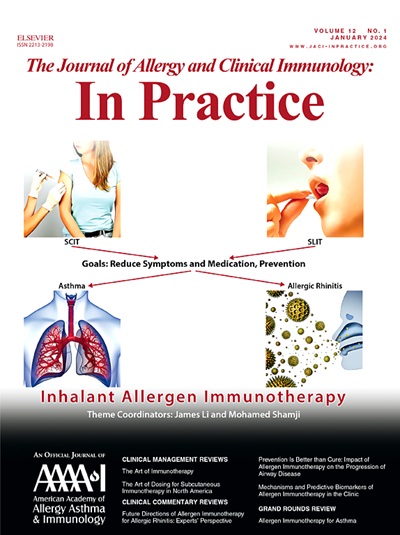万古霉素非 IgE 媒介反应的皮肤测试策略
IF 8.2
1区 医学
Q1 ALLERGY
Journal of Allergy and Clinical Immunology-In Practice
Pub Date : 2024-11-01
DOI:10.1016/j.jaip.2024.07.028
引用次数: 0
摘要
背景:据报道,万古霉素输注反应(VIR)是通过马氏相关 G 蛋白偶联受体-X2(MRGPRX2)介导的,是万古霉素诱导的主要即时药物反应(IDR)。在临床上,区分药物诱导即刻药物反应的基本机制对于未来的治疗策略至关重要,包括药物限制、重新给药和预处理注意事项。然而,由于缺乏经过验证的诊断测试,这具有挑战性,往往会导致不必要的药物限制:目的:确定皮内试验(IDT)和嗜碱性粒细胞活化试验(BAT)是否能区分万古霉素耐受者和万古霉素感染者:方法:对暴露于万古霉素的成人进行横断面研究,包括有 VIR 病史和无 VIR 病史者。收集了人口统计学资料、过敏相关合并症、万古霉素接触史和 VIR 特征。使用万古霉素进行了 IDT。比较各组之间的 IDT 剂量反应 EC50、IDT 相关局部症状和 BAT:结果:共招募了 11 名 VIR 受试者和 10 名耐受万古霉素的受试者。报告最多的 VIR 症状是瘙痒(82%)、潮红(82%)、荨麻疹(46%)、荨麻疹(46%)、血管性水肿(27%)和呼吸困难(19%)。VIR组的IDT剂量反应平均EC50为328微克/毫升(95% CI为296,367),而耐受组为1,166微克/毫升(95% CI为1029,1379)(p结论:皮试方法的变化有助于确定 IgE 以外的其他 IDR 机制。该皮试方案具有识别 VIR 的潜力,尤其是在患者接受多种药物治疗而 BAT 不足的情况下。未来的研究将验证和界定其预测价值,评估 VIR 的风险。本文章由计算机程序翻译,如有差异,请以英文原文为准。
A Skin Testing Strategy for Non–IgE-Mediated Reactions Associated With Vancomycin
Background
Vancomycin infusion reaction (VIR), reportedly mediated through Mas-Related G Protein–Coupled Receptor-X2, is the primary vancomycin-induced immediate drug reaction. Clinically, distinguishing the underlying drug-induced immediate drug reaction mechanisms is crucial for future treatment strategies, including drug restriction, re-administration, and pretreatment considerations. However, the lack of validated diagnostic tests makes this challenging, often leading to unnecessary drug restriction.
Objective
To determine whether intradermal tests (IDTs) and, separately, the basophil activation test (BAT) differentiate VIR from vancomycin-tolerant subjects.
Methods
This was a cross-sectional study of vancomycin-exposed adults with and without a history of VIR. Data on demographics, allergy-related comorbidities, history of vancomycin exposures, and VIR characteristics were collected. IDT with vancomycin was performed. IDT dose-response EC50, IDT-related local symptoms, and BAT results were compared between groups.
Results
A total of 11 VIR and 10 vancomycin-tolerant subjects were enrolled. The most reported VIR symptoms were pruritus (82%), flushing (82%), hives (46%), angioedema (27%), and dyspnea (19%). The IDT dose-response mean EC50 was 328 μg/mL (95% CI, 296-367) in the VIR versus 1166 μg/mL (95% CI, 1029-1379) in the tolerant group (P < .0001). All VIR subjects reported IDT-related local pruritus compared with 60% of tolerant subjects (P = .0185). The %CD63+ basophils were consistently less than 2%, without significant differences between groups (P < .54).
Conclusions
Variations in skin test methodologies could help identify other immediate drug reaction mechanisms beyond IgE. This skin test protocol holds the potential for identifying VIR, particularly in cases where patients have received multiple drugs while BAT is insufficient. Future studies will validate and delineate its predictive value, assessing the risk of VIR.
求助全文
通过发布文献求助,成功后即可免费获取论文全文。
去求助
来源期刊

Journal of Allergy and Clinical Immunology-In Practice
ALLERGYIMMUNOLOGY-IMMUNOLOGY
CiteScore
11.10
自引率
9.60%
发文量
683
审稿时长
50 days
期刊介绍:
JACI: In Practice is an official publication of the American Academy of Allergy, Asthma & Immunology (AAAAI). It is a companion title to The Journal of Allergy and Clinical Immunology, and it aims to provide timely clinical papers, case reports, and management recommendations to clinical allergists and other physicians dealing with allergic and immunologic diseases in their practice. The mission of JACI: In Practice is to offer valid and impactful information that supports evidence-based clinical decisions in the diagnosis and management of asthma, allergies, immunologic conditions, and related diseases.
This journal publishes articles on various conditions treated by allergist-immunologists, including food allergy, respiratory disorders (such as asthma, rhinitis, nasal polyps, sinusitis, cough, ABPA, and hypersensitivity pneumonitis), drug allergy, insect sting allergy, anaphylaxis, dermatologic disorders (such as atopic dermatitis, contact dermatitis, urticaria, angioedema, and HAE), immunodeficiency, autoinflammatory syndromes, eosinophilic disorders, and mast cell disorders.
The focus of the journal is on providing cutting-edge clinical information that practitioners can use in their everyday practice or to acquire new knowledge and skills for the benefit of their patients. However, mechanistic or translational studies without immediate or near future clinical relevance, as well as animal studies, are not within the scope of the journal.
 求助内容:
求助内容: 应助结果提醒方式:
应助结果提醒方式:


